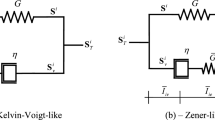Summary
The purpose of this work is to examine in detail the possibility to explain the decreasing of the initial shear modulus with increasing axial strain, observed first by Feigen, by means of the plastic-hypoelastic stress-strain relation suggested by Lehmann and by the author of the present paper.
Similar content being viewed by others
Abbreviations
- ɛ ij :
-
components of the infinitesimal strain tensor dilatation
- \(\varepsilon '_{ij} = \varepsilon ij - \frac{1}{3}\theta \delta _{ij} \) :
-
strain deviator
- σ ij :
-
components of the stress tensor
- θ:
-
spherical part of the stress tensor
- \(\sigma '_{ij} = \sigma _{ij} - \frac{1}{3}\Theta \delta _{\iota j} \) :
-
stress deviator
- τ 2=σ ′ ij σ ′ ij :
-
second invariant of the stress deviator
- ɛ=ɛ 33 :
-
axial strain
- e=ɛ 13 :
-
shear component of the strain tensor
- γ=2ɛ 13 :
-
shear strain
- σ=σ 33 :
-
axial stress
- s=σ 13 :
-
shear stress
- T ij :
-
components of Cauchy's stress tensor
- F ij :
-
components of the deformation gradient
- L ij :
-
components of the velocity gradient (Eulerian coordinates)
- \(D_{ij} = \frac{1}{2}(L_{ij} + L_{ji} )\) :
-
components of the rate of deformation tensor
- \(W_{ij} = \frac{1}{2}(L_{ij} - L_{ji} )\) :
-
components of the spin tensor
- \(d_{ij} = D_{ij} - \frac{1}{3}D_{kk} \delta _{ij} \) :
-
components of the rate of deformations deviator
- \(t_{ij} = T_{ij} - \frac{1}{3}T_{kk} \delta _{ij} \) :
-
components of Cauchy's stress deviator
- T=T 33 :
-
axial Cauchy's stress
References
Hill, R.: The mathematical theory of plasticity, Oxford 1971.
Naghdi, P. M.: Stress-strain relations in plasticity and thermoplasticity. In: Plasticity (Lee, E. H., Symonds, P. S., eds.). Pergamon Press 1960.
Ziegler, H.: An attempt to generalize Onsager's principle and its significance for rheological problems. ZAMP9, 748–763 (1958).
Ziegler, H.: An introduction to thermomechanics. Amsterdam-New York: Oxford 1977.
Lode, W.: Versuche über den Einfluß der mittleren Hauptspannung auf das Fließen der Metalle Eisen, Kupfer und Nickel. Z. Physik36, 913–939 (1962).
Taylor, G. I., Quinney, H.: The plastic distorsion of metals. Phil. Trans. Roy. Soc. (London)A 230, 323–362 (1931).
Feigen, M.: Inelastic behaviour under combined torsion. Proc. sec. U.S.-Nat. Congress of Appl. Mech., pp. 459–467 (1954)
Hecker, F. W.: Die Wirkung des Bauschinger-Effectes bei großen Torsion-Formänderungen. Dissertation TU Hannover 1967.
Moon, H.: An experimental study of the outer yield surface for annealed polycrystallin aluminium. Acta Mechanica24, 191–208 (1976).
Ohashi, Y., Tokuda, M.: Precise measurement of plastic behaviour of mild steel tubular specimens subjected to combined torsion and axial forces. J. Mech. Phys. Solids21, 241–261 (1973).
Blix, U.: Vergleich verschiedener Formänderungsgesetze der Plastizitätstheorie, Thesis, Ruhr-Universität Bochum, 1979.
Handelman, G. H., Lin, C. C., Prager, W.: On the mechanical behaviour of metals in the strain-hardening range. Quarterly Appl. Math.4, 397–407 (1946).
Lehmann, Th.: Zur Beschreibung großer plastischer Formänderungen unter Berücksichtigung der Werkstoffverfestigung. Rheol. Acta2, 247–254 (1962).
Mazilu, P.: A note on the constitutive law of plastic flow. Arch. Mech.26, 321–326 (1974)
Lehmann, Th.: On constitutive relations in thermoplasticity. Preprint, Bochum, 1980.
Bell, J. F.: A physical basis for continuum theories of finite strain plasticity: Part II. Arch. Rat. Mech. Anal.75, 103–126 (1981).
Green, A. E.: Hypoelasticity and plasticity. Proc. Roy. S. (London)A 234, 45–49 (1956).
Mazilu, P.: On a differential constitutive law. Rev. Roumaine de Math. Pures et Appl.19, 205–208 (1974).
Damm, U., Mazilu, P.: Some studies to Feigen's experiment. Internal Report of the Institute of Mechanics, Ruhr-Universität, Bochum.
Mazilu, P.: Verringerung des Anfang-Schubmoduls mit zunehmender axialer Dehnung erklärt mit Hilfe eines plasto-hypoelastischen Models. ZAMM64, T139-T141 (1983).
Author information
Authors and Affiliations
Additional information
With 7 Figures
Rights and permissions
About this article
Cite this article
Mazilu, P. Decreasing of the initial shear modulus with increasing axial strain explained by means of a plastic-hypoelastic model. Acta Mechanica 56, 93–115 (1985). https://doi.org/10.1007/BF01306026
Received:
Issue Date:
DOI: https://doi.org/10.1007/BF01306026



